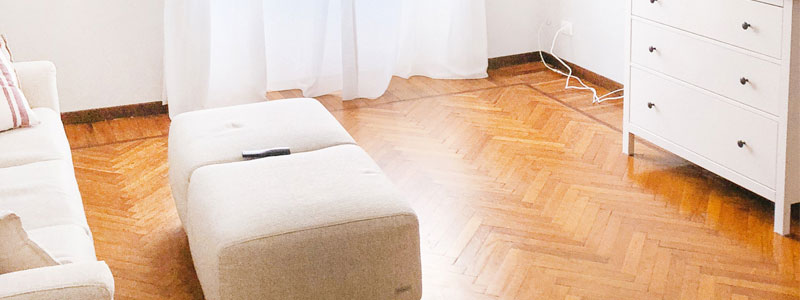Hardwood Finishes, Part 1: Urethanes
June 30, 2014
Finish is a major factor when it comes to both the appearance and the maintenance of your hardwood floors. Whether you are installing a new floor and trying to choose the right finish or are getting familiar with a hardwood floor in an older home, having a basic understanding of what’s out there can be a big help.
For a long time, the trend in the U.S. was toward high-gloss floors, an effect achieved either by frequent buffing and waxing or by specially formulated urethane coating. Nowadays, more natural looks have gained popularity, as have hand-scraped and distressed effects, and satin and matte finishes, better suited for these, have become more common.
There are basically two categories of hardwood finish—penetrating sealers and surface finishes. The first, as can be guessed by its name, essentially soaks into and bonds with the wood, strengthening its surface. The latter, as you might assume, forms a hard protective layer right on the surface of the wood.
Since surface finishes, in particular polyurethane finishes, are the most common in modern homes, we’ll discuss those first. But not to worry, we’ll get to the less common finishes in Part 2.
Helpful note: The term “polyurethane” refers to any material that incorporates a number of chemicals from the urethane chemical group. All urethane-based finishes fall into this category. So, though some labels may use the term “urethane” and others “polyurethane”, they are, for our purposes, one and the same.
Polyurethane finishes are especially appealing to homeowners because they are highly resistant to moisture, traffic, stains and spills. They tend to have a longer life than other finishes and are generally quite easy to maintain. Of course, this durability comes with a price—when it does finally come time to revive a surface-finished floor, a full refinish is usually required, involving sanding the entire floor down to fresh wood and beginning anew.

The variety of options for surface finishes in general is quite a bit broader than it is for other finishes, and this holds true for urethane finishes as well. For one, while other finishes can only be applied onsite once a floor is installed, a polyurethane finish can be applied onsite or can be applied by the manufacturer before delivery.
Though factory-finished flooring can initially be more costly, modern factories often make use of aluminum
oxide in the finishing process, rendering finishes that are exceptionally durable, some guaranteed for 20 years
and longer. Thus far, nothing that can be used for onsite finishing can even come close.
As the term implies “surface finish” implies, polyurethane finishes coat the surface of the boards, creating a thin but tough layer of synthetic resin that protects the floor. They can range from glossy to matte according to your preference and are colorless, though some may slightly darken or warm the natural or stained color below and can take on a slight amber tint as they age. There are currently four varieties of urethane finishes that can be applied onsite.
1. Oil-based polyurethane has been the most common and relied-upon surface finish for some time. For non-professionals, the slower-drying oil-based finish is helpful, as it tends to flow better, causing it to level out more evenly and allowing you to correct mistakes and work at a beginner’s pace without leaving lap marks. Of course, this means a longer drying period, about 24 hours, before you can use a newly finished floor, during which time your home will likely be filled with noxious fumes let off by the finish. Oil-based polyurethane provides a durable finish at a reasonable cost and brings out a certain richness in wood that other forms of urethane finish do not.
2. Water-based finishes can actually be urethane or acrylic, or a combination of the two. These finished have gained popularity in recent years as they release far fewer volatile organic compounds (VOCs) and noxious fumes than other similar finishes. Because water evaporates much more quickly than oil, water-based finishes dry comparatively quickly (in just a few hours). This can be a plus if the finish is being applied by an experienced hand, but can lead to lap marks when wet polyurethane is applied over dried or partially dried finish. Of course, they are also thinner, so tend to require more coats than oil-based polyurethane. This can be a problem on a budget, since decent water-based finishes tend to be more expensive than oil-based. They are also not nearly as durable as other urethane finishes, so are not recommended for areas with high foot traffic or homes with children or pets. Water-based finishes are, however, non-yellowing, so they can sometimes be preferable over lighter, creamy woods.
3. Acid-cure, or Swedish, finish is a less common but especially durable formulation of urethane finish known for its impressive ability to defend against moisture. It is fast-drying and resists the yellowing common to oil-based polyurethane finish. The downside is that acid-cure finish produces even stronger fumes than oil-based and is much more difficult to work, requiring the expertise of a skilled professional, which, of course, adds significantly to its cost.
4. Moisture-cure urethane finishes provide the most durability of the urethane finishes, but, like acid-cure, it can be tricky to apply and has a strong toxic odor. Moisture-cure is also non-yellowing and is most commonly used to create a glossy finish that can stand up to wear and tear.






